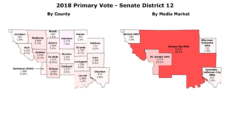Walter Schwietzer had tractor troubles. It wasn’t a complicated issue, but because there was software involved, Walter had to haul his tractor into the dealership, then wait a month. The total cost of the eventual fix was $5,000.
If he had had the right tools for the job, Walter thinks he could have had his tractor up and running with a day of work and about $500 in parts. Instead, he spent 10 times that and waited weeks when he should have been loading out hay. He lost time that he couldn’t get back.
Walter is a Montana farmer, but farmers in Missouri and across the U.S. deal with the same roadblocks from farm equipment manufacturers: They can’t fix their own equipment.
Farmers are used to repairing their own equipment when it breaks down so they can get on with their harvest. But as software has worked its way into modern farming equipment, manufacturers have restricted access to the corresponding software tools to fix the equipment when it breaks. ”Deere in the Headlights,” a new report from MO PIRG Education Fund, found that a single combine harvester can have as many as 125 software-connected sensors. That’s 125 different things that could go wrong that a farmer would need help to repair.
These days, you may need to interact with your car’s computer to do something as simple as change the oil. It’s the same with farm equipment. Even repairing a tractor’s turn signal requires a software fix.
But thanks to automotive “right to repair” legislation, car owners can buy the diagnostic software and tools themselves or go to an independent mechanic who has access to it. As Walter’s story shows, that’s not the case for farm equipment.
That’s why farmers are calling for the right to repair. They want to be able to get software tools — plus replacement parts and repair manuals — at a fair and reasonable price.
A bill in the Missouri Legislature, HB 975, would do just that. Called “Right to Repair,” the legislation would require manufacturers such as John Deere to provide farmers with fair access to repair essentials, including software tools, on fair and reasonable terms.
Right to repair legislation is a practical and concrete way to support farmers, but farm equipment manufacturers and dealers don’t like it. Why would they want Walter to spend $500 fixing his own tractor, when they could cash in $5,000 instead?
The reasons that manufacturers and their dealers give for opposing right to repair include a number of claims about the “threats” that the policy would open up. They claim giving farmers access to software tools would threaten farmer safety and the environment by allowing farmers to bypass safety and emissions controls and threaten manufacturers’ intellectual property by allowing access to source code.
These are serious allegations, and as environmental advocates, ones that we at Environment Missouri take seriously.
But of course, none of this is true. For example, opponents of right to repair, such as the Association of Equipment Manufacturers (AEM) and the Equipment Dealers Association (EDA), claim that, given the right to repair, farmers would steal “source code” — or what’s become a daunting and ambiguous opposition buzzword. Source code is written by engineers in a coding language (such as Java) and tells the machine what to do. The software farmers need to fix their equipment, however, is called embedded software: a compiled form of source code that’s readable by humans and gives away none of the manufacturers trade secrets. According to Kyle Wiens, CEO of the repair website iFixit, translating embedded software back into source code is essentially impossible.
In terms of opponents’ alarms of environmental catastrophe if farmers could fix their own equipment, it’s no surprise that those claims don’t hold up either. Opponents say that access to embedded software could allow them to “violate federal emissions laws.” The right to fix one’s combine and get on with the harvest, however, wouldn’t change EPA regulations, which deem emissions tampering illegal.
There’s even a case study to prove right to repair’s success and safety. The auto industry implemented a national right to repair standard for consumers and independent mechanics after the automotive right to repair law passed in Massachusetts in 2012. For the past decade, car owners and independent shops have had access to the software necessary to repair their cars. Money has been saved, cars have been fixed, and no havoc has been wrought.
Farmers don’t want to steal source code from manufacturers or release harmful emissions into the atmosphere. They just want to do their jobs without being left to the whims of equipment dealers. Right to repair would restore a fundamental freedom and an autonomous do-it-yourself culture to farmers in Missouri: If you bought it and you own it, you should be able to fix it. Environment Missouri supports agricultural right to repair, HB 975, and hopes it becomes law quickly — for farmer’s sake and for ours.

Bridget Sanderson is the state director for Environment Missouri. Anne Marie Green is a U.S. PIRG Right to Repair campaign Associate.

















